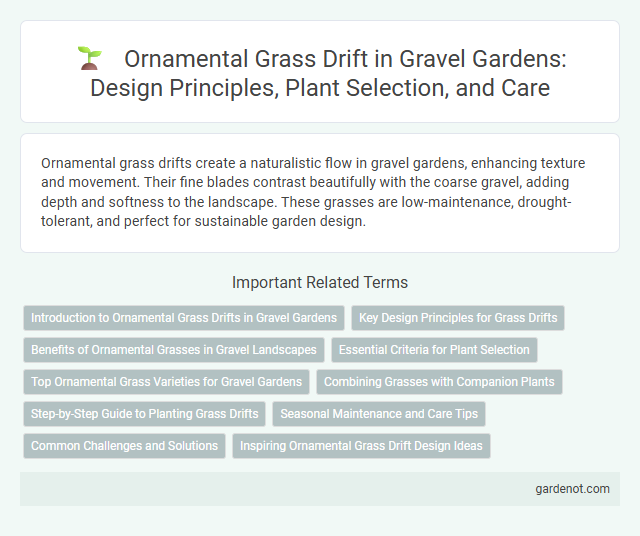Ornamental grass drifts create a naturalistic flow in gravel gardens, enhancing texture and movement. Their fine blades contrast beautifully with the coarse gravel, adding depth and softness to the landscape. These grasses are low-maintenance, drought-tolerant, and perfect for sustainable garden design.
Introduction to Ornamental Grass Drifts in Gravel Gardens
Ornamental grass drifts enhance gravel gardens by creating naturalistic, flowing textures with low-maintenance appeal. Species like Festuca glauca and Miscanthus sinensis thrive in well-drained gravel, adding vertical movement and year-round interest. These grasses improve soil stability and complement drought-tolerant planting schemes common in xeriscaping.
Key Design Principles for Grass Drifts
Ornamental grass drifts create naturalistic texture and movement, enhancing garden depth through mass planting of uniform species such as Miscanthus sinensis or Pennisetum alopecuroides. Key design principles include selecting grasses with varying heights and bloom times to ensure seasonal interest, positioning drifts to follow natural landscape contours for fluid visual flow, and integrating complementary perennials for contrast and biodiversity. Proper spacing avoids overcrowding, promoting healthy growth while emphasizing the rhythm and softness characteristic of successful gravel garden design.
Benefits of Ornamental Grasses in Gravel Landscapes
Ornamental grasses in gravel gardens enhance biodiversity by providing habitat for pollinators and beneficial insects. Their deep root systems improve soil stability and reduce erosion, making gravel landscapes more sustainable. These grasses also require minimal maintenance and water, offering an eco-friendly solution for drought-prone areas.
Essential Criteria for Plant Selection
Ornamental grass drifts in gravel gardens thrive when selecting species with drought tolerance, slow growth rate, and low maintenance needs to ensure sustainability and visual appeal. Opt for grasses such as Festuca glauca or Carex testacea that exhibit strong root systems for soil stabilization and seasonal color variation. Prioritizing plants with pest resistance and adaptability to varying sunlight conditions enhances long-term garden resilience and aesthetic coherence.
Top Ornamental Grass Varieties for Gravel Gardens
Top ornamental grass varieties for gravel gardens include Festuca glauca, known for its steel-blue foliage and drought tolerance; Pennisetum alopecuroides, prized for its graceful, arching plumes that add texture and movement; and Carex buchananii, offering unique coppery bronze blades ideal for contrasting against gravel. These grasses thrive in well-drained, low-maintenance gravel garden environments while enhancing visual interest and biodiversity. Selecting varieties with varying heights and colors ensures year-round appeal and complements the minimalist aesthetic of gravel landscaping.
Combining Grasses with Companion Plants
Ornamental grass drifts create dynamic textures and movement in gravel gardens, enhancing visual interest through layered planting schemes. Combining grasses like Miscanthus or Pennisetum with drought-tolerant companions such as lavender, sedum, or heuchera boosts biodiversity and resilience while complementing the garden's naturalistic aesthetic. Selecting species with varied heights, foliage colors, and flowering periods ensures a balanced composition that thrives in well-drained, gravelly soils.
Step-by-Step Guide to Planting Grass Drifts
Selecting drought-tolerant ornamental grasses such as Festuca glauca or Carex oshimensis ensures low-maintenance and year-round texture in a gravel garden. Prepare the site by loosening soil within the drift area and incorporating organic compost to enhance drainage and nutrient availability. Space the grasses evenly, typically 12 to 18 inches apart, to allow natural spreading and create a cohesive, flowing appearance across the gravel bed.
Seasonal Maintenance and Care Tips
Ornamental grass drifts in gravel gardens require seasonal pruning to remove dead foliage, promoting healthy new growth and maintaining an attractive appearance. Applying mulch around the base helps retain moisture and suppress weeds, crucial during dry summer months. In late winter or early spring, cutting back grasses to a few inches above ground prepares them for vigorous growth in the upcoming season.
Common Challenges and Solutions
Ornamental grass drifts in gravel gardens often face challenges such as soil compaction, poor drainage, and weed infiltration, which can hinder plant growth and aesthetics. Implementing well-aerated gravel substrates and incorporating organic mulch layers improves moisture retention and root health, mitigating these issues effectively. Regular maintenance, including targeted weeding and periodic soil amendment, ensures ornamental grass drifts remain vibrant and resilient in gravel garden landscapes.
Inspiring Ornamental Grass Drift Design Ideas
Ornamental grass drifts create dynamic textures and movement in gravel gardens, emphasizing natural flow and contrast with stone elements. Varieties like Miscanthus sinensis and Pennisetum alopecuroides add height and softness, enhancing visual interest while requiring minimal maintenance. Strategic grouping of these grasses maximizes seasonal color variation and complements drought-tolerant planting schemes.
Ornamental grass drift Infographic

 gardenot.com
gardenot.com